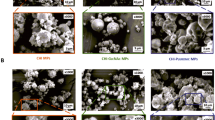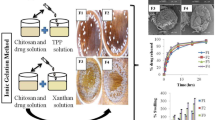Abstract
Purpose
The main purpose of this study is to introduce a new adjuvant treatment for H. pylori that aims to enhance therapy outcomes. The research question is how to create a controlled-release gastro-retentive floating system using a combination of chitosan (CS) and beeswax (BW) and to evaluate the release behavior of curcumin as an active ingredient.
Methods
In this study, a new formula combining CS and BW was developed through a hot melting process to create a controlled-release gastro-retentive floating system. Response surface methodology (RSM) was employed to determine the optimal conditions and concentrations of CS and BW to produce the desired floating system. Parameters such as mixing time, processing melting temperature, and concentration of BW were evaluated.
Results
The study found that the optimal parameters for the CS/BW formulation were determined as follows: a mixing time of 3 min, a processing melting temperature of 92.2 °C, and a BW concentration of 13.3% (w/w). Curcumin was incorporated into the optimal tablet, and its release behavior was evaluated. The results showed a full floating behavior of the tablet and a zero-order release behavior in acidic conditions.
Conclusions
The study successfully introduced a new adjuvant treatment for H. pylori that utilizes a controlled-release gastro-retentive floating system. The combination of CS and BW, along with the incorporation of curcumin, showed promising results in terms of floating behavior and release kinetics. This new treatment approach has the potential to enhance therapy outcomes for H. pylori infections.








Similar content being viewed by others
Data Availability
Data will be available from the corresponding author upon reasonable request.
References
Abbas A, Alhamdany A. Floating microspheres of enalapril maleate as a developed controlled release dosage form: investigation of the effect of an ionotropic gelation technique. Turkish J Pharm Sci. 2020;17(2):159.
Henriques P, Costa L, Seabra C, Antunes B, Silva-Carvalho R, Junqueira-Neto S, et al. Orally administrated CS microspheres bind Helicobacter pylori and decrease gastric infection in mice. Acta Biomaterialia. 2020;114:206–20.
Graham D, Fischbach L. Helicobacter pylori treatment in the era of increasing antibiotic resistance. Gut. 2010;59(8):1143–53.
Song H, Zhou L, Liu D, Ge L, Li Y. Probiotic effect on Helicobacter pylori attachment and inhibition of inflammation in human gastric epithelial cells. Exp Ther Med. 2019;18(3):1551–62.
Georgopoulos S, Papastergiou V. An update on current and advancing pharmacotherapy options for the treatment of H. pylori infection. Expert Opin Pharmacother. 2021;22(6):729–41.
Bardonnet P, Faivre V, Pugh W, Piffaretti J, Falson F. Gastroretentive dosage forms: overview and special case of Helicobacter pylori. J Control Release. 2006;111(1–2):1–18.
Yun Y, Lee B, Park K. Controlled drug delivery: historical perspective for the next generation. J Control Release. 2015;219:2–7.
Sunoqrot S, Hasan L, Alsadi A, Hamed R, Tarawneh O. Interactions of mussel-inspired polymeric nanoparticles with gastric mucin: implications for gastro-retentive drug delivery. Colloids Surf B. 2017;156:1–8.
Ouda G, Dahmash E, Alyami H, Iyire A. A novel technique to improve drug loading capacity of fast/extended release orally dissolving films with potential for paediatric and geriatric drug delivery. AAPS PharmSciTech. 2020;21(4):1–14.
Omachi Y. Gastroretentive Sustained-Release Tablets Combined with a Solid Self-Micro-Emulsifying Drug Delivery System Adsorbed onto Fujicalin®. AAPS PharmSciTech. 2022;23(5):1–22.
Sousa A, Serra J, Estevens C, Costa R, Ribeiro A. A quality by design approach in oral extended release drug delivery systems: where we are and where we are going? J Pharm Investig. 2022;1–38.
Vinchurkar K, Sainy J, Khan M, Mane S, Mishra D, Dixit P. Features and Facts of a Gastroretentive Drug Delivery System-A Review. Turk J Pharm Sci. 2022;19(4).
Palla S, Kotha R, Paladugu A, Reddy E, Adavi S, Reddy K. Bilayer Floating Tablets for Gastroretentive Drug Delivery System. Int J Pharm Sci. 2013;6(3):2097–112.
Varshi R, Jain V, Pal P. A review on Advanced approaches and polymers used in gastroretentive drug delivery systems. J drug deliv ther. 2022;12(4):181–5.
Panigrahi K, Patra C, Jena G, Ghose D, Jena J, Panda S, Sahu M. Gelucire: a versatile polymer for modified release drug delivery system. Future J Pharm Sci. 2018;4(1):102–8.
Iglesias N, Galbis E, Romero-Azogil L, Benito E, Lucas R, García-Martín M, de-Paz M. In-depth study into polymeric materials in low-density gastroretentive formulations. Pharmaceutics. 2020;12(7):636.
Wang L, Shang L, Shan D, Che X. Long-term floating control-released intravesical preparation of 5-fluorouracil for the local treatment of bladder cancer. Drug Dev Ind Pharm. 2017;43(8):1343–50.
Sapavatu S, Jadi R. Formulation development and characterization of gastroretentive drug delivery systems of loratadine. Int J Appl Pharm. 2019;11:91–9.
Janjale V, Patil S, Fegade T. A Review on: floating Microsphere. Am J Pharm Educ. 2020;10(02):232–59.
Fratini F, Cilia G, Turchi B, Felicioli A. BW: a minireview of its antimicrobial activity and its application in medicine. Asian Pac J Trop Med. 2016;9(9):839–43.
Carbajal D, Molina V, Valdés S, Arruzazabala L, Más R. Anti-ulcer activity of higher primary alcohols of BW. J Pharm Pharmacol. 1995;47(9):731–3.
Dinat S, Orchard A, Van Vuuren S. A systematic review of African natural products against gastric ulcers and Helicobacter pylori. J Ethnopharmacol. 2022;115698.
Alsamydai A, Jaber N. Pharmacological aspects of curcumin. Int J Pharm. 2018;5(6):313–26.
Hamam F, Al-Remawi M. The novel delivery system of curcumin through a transdermal route using sub-micronized particles composed of mesoporous silica and oleic acid. J Funct Foods. 2014;8:87–99.
Alam J, Dilnawaz F, Sahoo S, Singh D, Mukhopadhyay A, Hussain T, Pati S. Curcumin encapsulated into biocompatible co-polymer PLGA nanoparticle enhanced anti-gastric cancer and anti-Helicobacter Pylori effect. Asian Pac J Cancer Prev. 2022;23(1):61.
Mohammadi A, Khanbabaei H, Zandi F, Ahmadi A, Haftcheshmeh S, Johnston T, Sahebkar A. Curcumin: A therapeutic strategy for targeting the Helicobacter pylori-related diseases. Microb Pathog. 2022;105552.
Gupta S, Patchva S, Aggarwal B. Therapeutic roles of curcumin: lessons learned from clinical trials. AAPS J. 2013;15(1):195–218.
Al-Remawi M. Quality by design of curcumin-loaded calcium alginate emulsion beads as an oral controlled release delivery system. J Excip Food Chem. 2016;6(2)
Siva Gangi Reddy N, Madhusudana Rao K, Park S, Kim T, Chung I. Fabrication of aminosilanized halloysite based floating biopolymer composites for sustained gastro retentive release of curcumin. Macromol Res. 2019;27(5):490–6.
Al-Remawi M, Abdullah M. Controlled release pharmaceutical composition. European patent publication number (EP2716282); 2014.
Al-Remawi M, Hamam F, Hamaidi M. Quality by design approach to prepare oleoyl alginate derivative and its use in transdermal delivery. Pharm Dev Technol. 2015;20(2):227–36.
Al-Akayleh F, Jaber N, Al-Remawi M. Designing, preparation, and evaluation of orodispersible chitosan anionic salt tablets. J Pharm Innov. 2020;1–13.
Jaimini M, Rana A, Tanwar Y. Formulation and evaluation of famotidine floating tablets. Curr Drug Deliv. 2007;4(1):51–5.
Khan I, Lau K, Bnyan R, Houacine C, Roberts M, Isreb A, et al. A facile and novel approach to manufacture paclitaxel-loaded proliposome tablet formulations of micro or nano vesicles for nebulization. Pharm Res. 2020;37(6):1–19.
Al-Remawi M. Application of N-hexoyl CS derivatives with high degree of substitution in the preparation of super-disintegrating pharmaceutical matrices. J Drug Deliv Sci. 2015;29:31–41.
Pitt K, Sinka C. Tabletting. In Handbook of powder technology (Vol. 11, pp. 735–778). Elsevier Science BV; 2017.
Al-Akayleh F, Jaber N, Al-Remawi M, Al Odwan G, Qinna N. CS-biotin topical film: preparation and evaluation of burn wound healing activity. Pharm Dev Technol. 2022;27(4):479–89.
Al-Remawi M, Jaber N, Elsayed A, Alsafadi D, Salah K. Stabilization of insulin using low molecular weight CS carbonate nanocarrier. Carbohydr Polym. 2022;291:119579.
Pontier C, Champion E, Viana M, Chulia D, Bernache-Assollant D. Use of cycles of compression to characterize the behaviour of apatitic phosphate powders. J Eur Ceram. 2002;22(8):1205–16.
Rachmawati H, Yee C, Rahma A. Formulation of tablet containing curcumin nanoemulsion. Int J Pharm Pharm Sci. 2014;6(3):115–6.
Hazra K, Kumar R, Sarkar B, Chowdary Y, Devgan M, Ramaiah M. UV-visible spectrophotometric estimation of curcumin in nanoformulation. Int J Pharmacogn. 2015;2:127–30.
Svečnjak L, Baranović G, Vinceković M, Prđun S, Bubalo D, Gajger I. An approach for routine analytical detection of beeswax adulteration using FTIR-ATR spectroscopy. J Apic Sci. 2015;59(2):37–49.
Tinto W, Elufioye T, Roach J. Waxes. In Pharmacognosy (pp. 443–455). Academic Press; 2017.
Diyana Z, Jumaidin R, Selamat M, Suan M. Thermoplastic starch/BW blend: characterization on thermal mechanical and moisture absorption properties. Int J Biol Macromol. 2021;190:224–32.
Rodríguez-Núñez JR, Madera-Santana TJ, Sánchez-Machado DI, López-Cervantes J, Soto Valdez H. Chitosan/hydrophilic plasticizer-based films: preparation, physicochemical and antimicrobial properties. J Polym Environ. 2014;22:41–51.
Bakry N, Isa M, Sarbon N. Effect of sorbitol at different concentrations on the functional properties of gelatin/carboxymethyl cellulose (CMC)/CS composite films. Int Food Res J. 2017;24(4):1753–62.
Amberkar T, Mahanwar P. Study of BW–Carbon Nanotubes-Paperboard Nanocomposite for Temperature Regulation of Packaging Container. Mater Proc. 2022;9(1):9.
Huang Y, Huang Z, Watanabe C, Wang L. Combined direct analysis in real-time mass spectrometry (DART-MS) with analytical pyrolysis for characterization of Chinese crude propolis. J Anal Appl Pyrolysis. 2019;137:227–36.
Li Y, Qia J, Wang Z, Qu L, Gao J, Yi S, He Z. Effect of beeswax impregnation on the dimensional stability, surface properties, and thermal characteristics of wood. BioResources. 2020;15(2):2181–94.
Luckachan G, Pillai C. Chitosan/oligo L-lactide graft copolymers: effect of hydrophobic side chains on the physico-chemical properties and biodegradability. Carbohydr Polym. 2006;64(2):254–66.
Baskar D, Kumar T. Effect of deacetylation time on the preparation, properties, and swelling behavior of chitosan films. Carbohydr Polym. 2009;78(4):767–72.
Hossain M, Rahman M, Ketata C, Mann H, Islam M. SEM-based structural and chemical analysis of paraffin wax andbeeswax for petroleum applications. J Charact Dev Nov Mater. 2009;1:21–38.
Jozwiakowski M, Jones D, Franz R. Characterization of a hot-melt fluid bed coating process for fine granules. Pharm Res. 1990;7:1119–26.
Patel S, Kaushal A, Bansal A. The effect of starch paste and sodium starch glycolate on the compaction behavior of wet granulated acetaminophen formulations. J Excip Food Chem. 2016;2(3).
Bakre LG, Ladele BA. Development and evaluation of gastroretentive ciprofloxacin floating tablets using Chrysophyllum albidum gum. J Pharm Pract Res. 2019;49(3):240–5.
Rahim SA, Carter PA, Elkordy AA. Design and evaluation of effervescent floating tablets based on hydroxyethyl cellulose and sodium alginate using pentoxifylline as a model drug. Drug Des Devel Ther. 2015;31:1843–57.
Acknowledgements
The authors are thankful for the Deanship of Scientific Research at University of Petra for funding this research.
Funding
The study was funded by a grant (4-2022) of the Deanship of Scientific Research from University of Petra (UOP), Amman, Jordan.
Author information
Authors and Affiliations
Contributions
The author confirms sole responsibility for the following: Al Remawi M: Study conception, design, and manuscript preparation. Jaber N and Abdel-Rahem R.: data collection, analysis and interpretation of results.
Corresponding author
Ethics declarations
Ethics Approval
NA.
Consent
NA.
Competing Interest
The authors declare that they have no known competing financial interests or personal relationships that could have appeared to influence the work reported in this paper.
Additional information
Publisher's Note
Springer Nature remains neutral with regard to jurisdictional claims in published maps and institutional affiliations.
Rights and permissions
Springer Nature or its licensor (e.g. a society or other partner) holds exclusive rights to this article under a publishing agreement with the author(s) or other rightsholder(s); author self-archiving of the accepted manuscript version of this article is solely governed by the terms of such publishing agreement and applicable law.
About this article
Cite this article
Jaber, N., Al-Remawi, M. & Abdel-Rahem, R. Novel Chitosan Beeswax Matrix for Gastro-Retentive Delivery of Curcumin: A Promising Adjuvant Therapy for Helicobacter Infection. J Pharm Innov 19, 16 (2024). https://doi.org/10.1007/s12247-024-09824-y
Accepted:
Published:
DOI: https://doi.org/10.1007/s12247-024-09824-y




